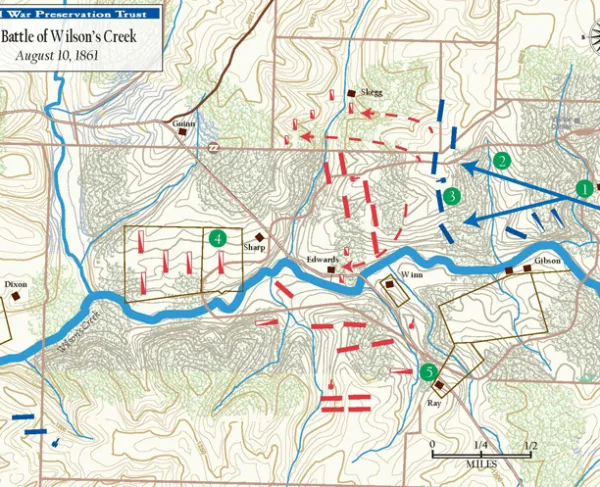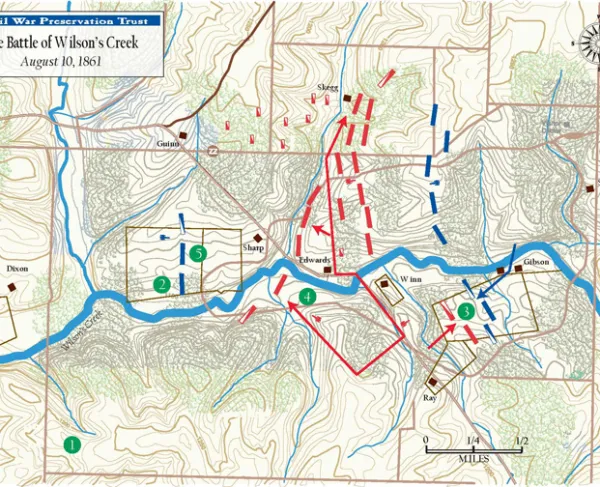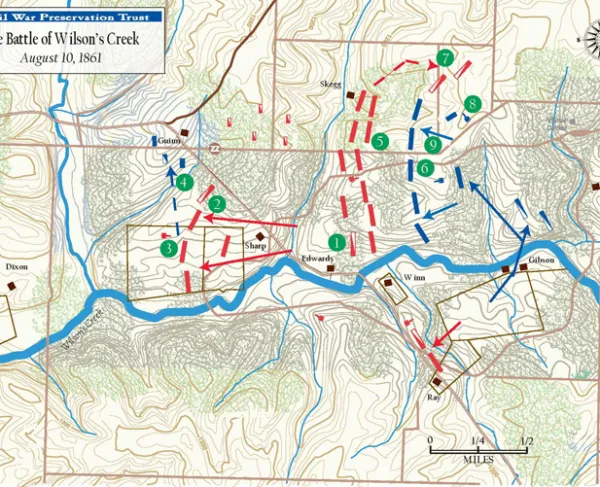Missouri's Bloody Hill
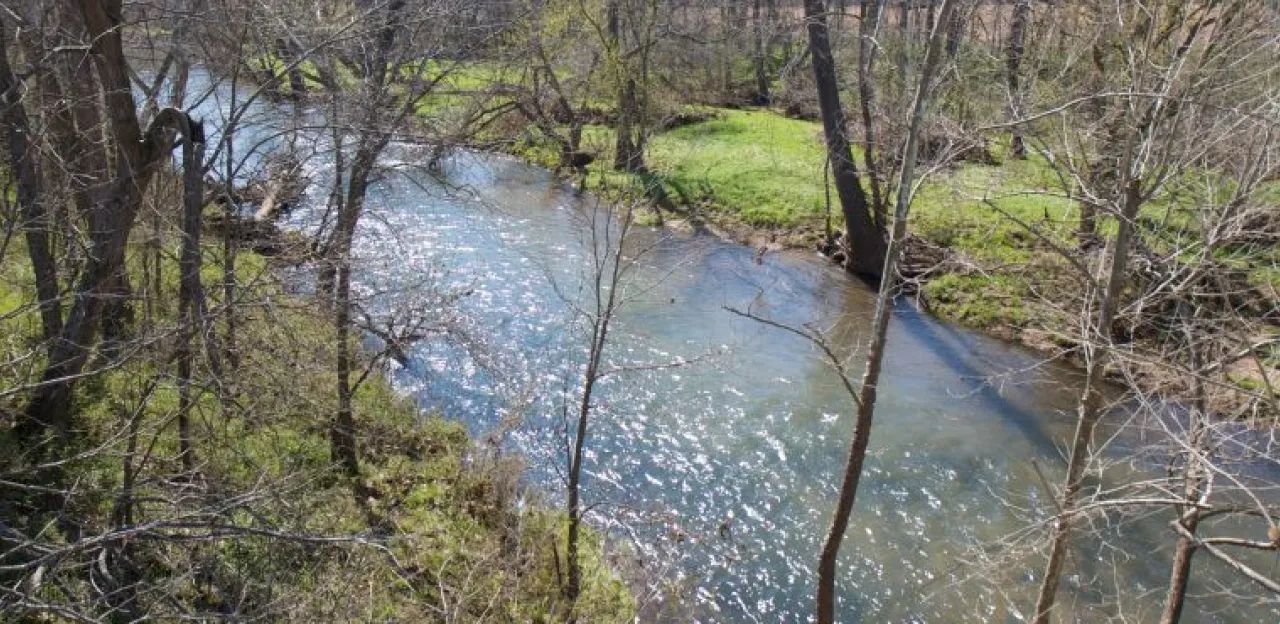
By Jeff Patrick, for Hallowed Ground, Summer 2011
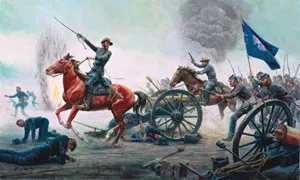
In early August 1861, just as the smoke cleared from the fields around Virginia’s Bull Run, two armies began to concentrate in Missouri, preparing for what would be the second major battle of the Civil War. The coming engagement would largely determine the fate of Missouri, a slave-holding Border State, for the duration of the war.
The North’s situation was desperate. Union Brig. Gen. Nathaniel Lyon had concentrated troops in and around Springfield, at the gateway to the Ozarks in southwestern Missouri. Many of Lyon’s volunteers were nearing the end of their initial, short-term enlistments, and although Lyon begged his superiors for more troops and supplies, his pleas were denied.
To oppose Lyon, Confederate troops from states west of the Mississippi River had begun arriving to reinforce Maj. Gen. Sterling Price’s pro-secessionist Missouri State Guard. These Southern troops outnumbered Lyon’s army two-to-one. Approaching Springfield, they halted and encamped on both sides of Wilson’s Creek, about 10 miles from the city.
While Confederate Brig. Gen. Benjamin McCulloch, the overall Southern commander, laid the groundwork for an attack on Springfield, Lyon laid plans for a surprise attack on the Southerners. Lyon hoped to cripple his enemy, allowing him to retreat safely to the railhead at Rolla.
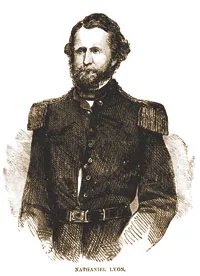
General Lyon was conscious of the fact that almost half of his troops were German immigrants, with an almost blind loyalty to Brig. Gen. Franz Sigel, and that hundreds had already left the army when their enlistment was up and headed for Springfield. In order to entice the remaining troops to stay on, General Lyon accepted a plan brought forward by Sigel to divide the Federal army and launch attacks on both the southeast and rear of the Confederate army. Lyon confided to his trusted officers that “Sigel has a great reputation, and if I fail against his advice it will give Sigel command and ruin me. Then again, unless he can have his own way, I fear he will not carry out my plans.”
Shortly after conferring with his officers, Lyon received a report from a Federal cavalry unit, under the command of Capt. David S. Stanley, stating that captured Confederate cavalrymen had admitted that the Missouri State Guard was now united with the main army under McCulloch and Arkansas State Troops at Wilson’s Creek. Lyon realized now that Sigel’s plan was futile, but he did not change it.
Lyon addressed each of his regiments as they prepared to march. He seemed tired and uninspired, offering advice instead of inspiration — “Don’t shoot until you get orders. Fire low — don’t aim higher than their knees; wait until they get close; don’t get scared; it’s no part of a soldier’s duty to get scared.”
An evening shower on August 9 prompted McCulloch to cancel his planned march on Springfield. In the meantime, Lyon’s Union army left Springfield in two columns — one under his command, the other led by Sigel — to attack the enemy camp from two directions. Lyon’s column was comprised of 4,300 men from Missouri, Kansas and Iowa. Sigel’s 1, 100 men were all Missourians. Stealth was the order, and the wheels of the artillery and the horses’ hooves were wrapped in blankets and burlap to muffle their sound.
Lyon’s column reached its objective at about 1 a.m. on August 10, and the men lay down to rest and await the dawn. Maj. John M. Schofield, Lyon’s chief of staff, remembered that the general was “oppressed with the responsibility of his situation, with anxiety for the cause, and with sympathy for the Union people in that section.” Lyon appeared to have a premonition of what was to come, and he told Schofield, “I am a believer in presentiments, and I have a feeling that I can’t get rid of that I shall not survive this battle.” He later added, “I will gladly give my life for a victory.”
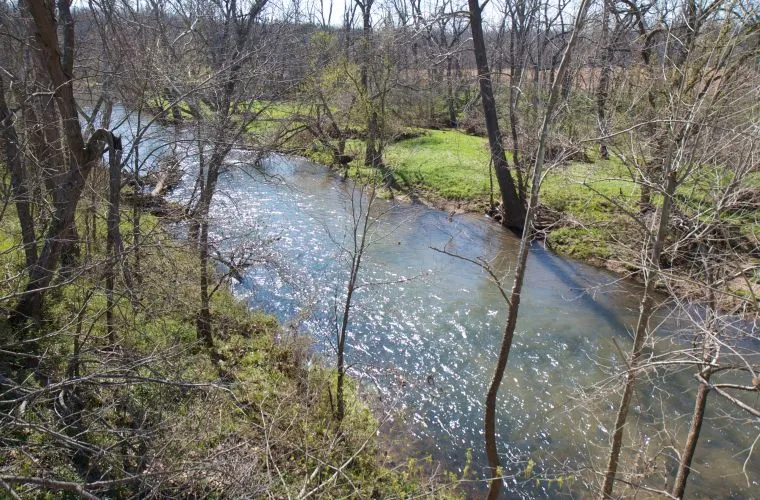
Meanwhile, Sigel’s column had also arrived at its destination, and he positioned his guns overlooking the Southern cavalry encamped in farmer Joseph Sharp’s fields below. The Confederates appeared to be sleeping peacefully, and Sigel now waited for the sound of Lyon’s guns to start his attack.
Fighting erupted at 5:00 a.m., when Lyon’s troops encountered a small force of Missouri State Guard cavalrymen and forced them to retreat. The Confederate commanders had been caught by surprise. As Generals McCulloch and Price sat eating their breakfast, a messenger arrived with the news that the Federal army was “approaching with twenty thousand men and 100 pieces of artillery.” Another messenger soon arrived announcing that “the main body of enemy is upon us.” The two generals immediately headed north to survey the situation.
Lyon soon divided his force again, ordering the Missouri Home Guard and a battalion of U.S. Regulars under Capt. Joseph Plummer to ford Wilson’s Creek and secure the Federal left flank. The remainder of Lyon’s column continued to drive south toward a height later christened “Bloody Hill.” When the sounds of this battle reached Sigel, he began a bombardment that drove the Southerners at the Sharp Farm away in a panic. The engagement was so fierce that the cannon fire was heard more than 10 miles away in Springfield. Sigel began a triumphant advance.
At 6:00 a.m., as Lyon’s troops crested Bloody Hill, they were slowed by fire from the Pulaski Arkansas Battery. But Lyon was undeterred and remarked to Schofield that the Confederates “in less than an hour [will] wish they were a thousand miles away.” Now alerted to the danger, McCulloch ordered Price’s State Guard forward to meet Lyon’s onslaught. The Missourians began moving from their camps and pressed cautiously up Bloody Hill. With this action, the Southerners seized the initiative from Lyon, who went on the defensive thereafter.
As Plummer moved through farmer John Ray’s cornfields, the effectiveness of the Pulaski Battery became increasingly evident. His march was redirected toward Bloody Hill, but was met by a Confederate column some 1,000 strong under Col. James McIntosh. The fighting was intense and Plummer was forced to retreat west of Wilson’s Creek. Union artillery fire from Bloody Hill dispersed the Southern pursuers — including a regiment of “green” Louisiana troops who dove to the ground after every round of artillery was fired. The Confederates had suffered about 100 casualties, while Plummer lost 80 men and was wounded.
Meanwhile, Sigel’s men were deployed —albeit poorly — around the Sharp House. More than 1,800 Confederate cavalrymen were camped nearby, as well as 2,000 unarmed State Guardsmen and dozens of “camp followers,” which included slaves and women. At about 5:30 a.m., with the sound of Lyon’s guns coming from the north, Sigel opened up on the camp. The artillery barrage caught the camp’s inhabitants completely unaware and dozens immediately took flight into the woods. Seeing the chaos and confusion, Sigel ordered his cavalry and two infantry regiments to advance across Wilson’s Creek, followed by the artillery. More than 100 prisoners were taken, and Sigel became confident that his plan was working. He ordered his men to rest for almost an hour before moving them forward once again.
By 8:30 a.m., Sigel was convinced of his victory. After a second bombardment toward the woods, dozens of Confederates emerged and began to surrender. He also spotted large numbers of men moving south along the east ridges of the creek and mistakenly believed that Lyon was pushing McCulloch’s army back. As a result, he only deployed a small number of skirmishers to his front, leaving his column open and unprotected.
The men Sigel had spotted were in actuality the 3rd Louisiana and some Missourians and Arkansans troops that McCulloch had gathered together. Supported by two artillery batteries, they launched a surprise attack. When Sigel’s skirmishers encountered the first of McCulloch’s troops, they immediately returned to their lines, mistakenly informing Sigel that Lyon’s men were advancing toward them. Concerned that his men might fall under friendly fire, Sigel sent a color bearer forward to display the United States flag. When the Confederates were just 40 yards from the Federal lines, they opened fire with rifles and artillery, taking Sigel’s troops by complete surprise.
Even after the initial exchange of gunfire, Sigel hesitated to return fire, believing that the men were part of Lyon’s column. Uniforms had not yet been standardized this early in the war, and many Union troops thought that the gray uniformed soldiers emerging from the woods were from the First Iowa Regiment, which had several companies wearing gray. With most of his men refusing to fire, Sigel was overwhelmed, and his brigade took flight.
Confederate cavalry attempted to pursue the men, but the Federals had dispersed in two different directions. Sigel and 250 men headed back to Springfield, with Sigel barely avoiding capture by hiding in a cornfield. His total losses were more than 64 killed and 147 captured.
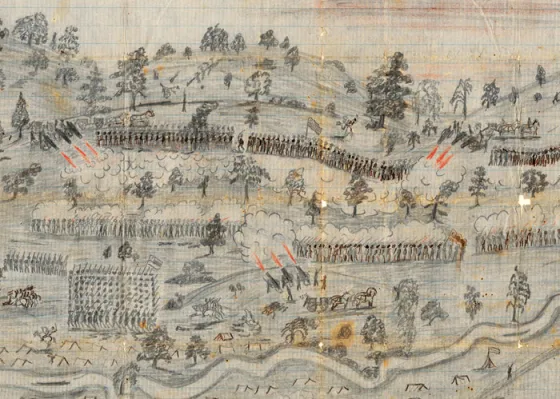
Back on Bloody Hill, Gen. James McBride’s Missouri State Guard division launched an unsuccessful attack on Lyon’s right flank, only adding to the blood already spilled there.
At about 9:00 a.m., Price began a second assault on the heights, nearly breaking the center of the Union line. The fighting was especially intense, with the Confederates forming three or four ranks deep and firing while lying down, kneeling, and standing. They faced Lyon’s 3,500 men and 10 cannon for more than an hour at close range. As the smoke from the powder grew thicker, men fired blindly into each other. The August heat also began to take its toll as men fell from heat exhaustion as well as wounds.
Lyon had dismounted his horse to direct the battle on foot. He had been grazed by bullets in the right leg and on the side of his head. He remarked to Schofield, “It is as I expected. Major, I am afraid the day is lost.” Schofield replied, “No, General; let us try it again!” Spurred on by his chief of staff’s enthusiasm, Lyon mounted a horse and rode toward the center of the fighting. Defiant against his aides’ pleas not to endanger himself, Lyon replied, “I am but doing my duty.”
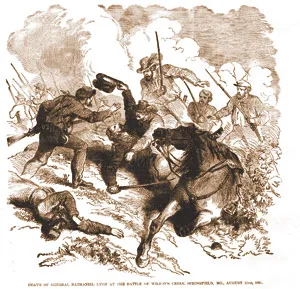
Lyon began repositioning his troops to fill a gap between the First Iowa and First Missouri regiments, and he moved the Second Kansas in behind the Iowans. Waving his hat in the air, Lyon cried, “Come on, my brave boys, I will lead you! Forward!” Just then the Confederates let loose a volley of fire. Lyon was hit in the chest and fell from his horse. An aide ran to help him, but it was too late. With his death, Lyon became the first Union general killed in combat during the Civil War, and command of the Union Army of the West passed to Maj. Samuel Sturgis. After about an hour of combat, Price disengaged his troops, and the Southerners retired down the hill to regroup.
At about 10:30 a.m., the third and largest Confederate assault against Bloody Hill began, but ultimately also ended in failure. As the Southerners fell back, Sturgis assessed his position. With heavy casualties, his supplies of ammunition almost exhausted and no word from Sigel, Sturgis ordered his men to retreat. By 11:30 a.m., the battle was over. The Southerners, disorganized and low on ammunition, decided not to pursue their withdrawing foe.
Although a relatively small engagement by the standards set later in the war, Wilson’s Creek was a large one for 1861. Lyon’s army lost nearly a quarter of its strength, while 12 percent of the Southern army became casualties. More than 535 dead and 2,000 wounded or missing soldiers littered the field. It had been, as one Southern participant recalled, “a mighty mean-fowt fight.”
Wilson’s Creek was a tactical victory for the Southerners, but due to later dissention between McCulloch and Price, they did not follow up their advantage. This set the stage for greater Federal military activity in Missouri and the decisive Union victory at Pea Ridge, Ark., in March 1862. Although plagued by guerrilla warfare and internal strife, Missouri remained under Union control for the remainder of the conflict.
Learn More: Wilson's Creek
Jeff Patrick oversees the John K. and Ruth Hulston Civil War Research Library at Wilson’s Creek National Battlefield. The author of numerous articles on military history and the editor of two Civil War diaries, his most recent work is Campaign for Wilson’s Creek: The Fight for Missouri Begins (McWhiney Foundation Press, May 2011).
